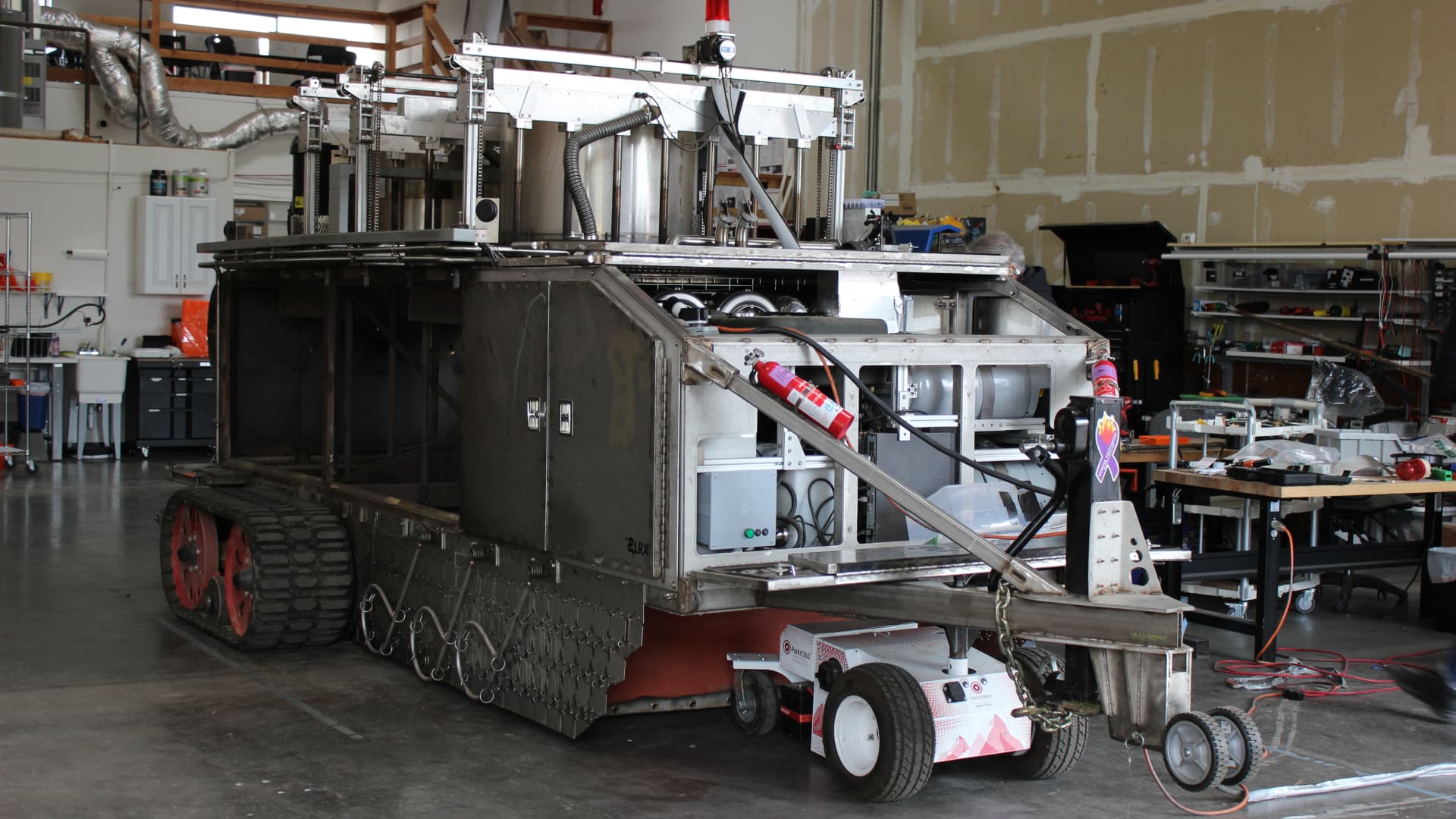BurnBot RX burns unwanted vegetation without emitting plumes of smoke.
Lora Kolodny for CNBC
Last year’s record heat wave worsened drought and dry conditions across the globe, a particularly calamitous situation for California, which has seen 13 of the state’s 20 most destructive wildfires in history break out since 2017.
In South San Francisco, a small startup is working on a high-tech approach to wildfire prevention.
Anukool Lakhina and Waleed “Lee” Haddad founded BurnBot in 2022 to develop robotics and remote-controlled vehicles that can munch up and burn away invasive plants or other dry vegetation that can fuel fires if left fallow.
BurnBot has just raised a $20 million funding round led by climate-focused ReGen Ventures, for expansion, hiring, and to develop new machines that can traverse steeper hills and get into tighter spaces.
Before BurnBot, firefighters and land owners had to use expensive, time-consuming and more dangerous options like grazing away the vegetation (typically with goats), burning it, applying herbicides or removing vegetation mechanically with a mix of equipment and manual labor.
“The sort of traditional way to do a prescribed burn is with drip torches, and that requires a large number of people,” said Lakhina, BurnBot’s CEO. “A drip torch is like a diesel watering can. You go around, you drop diesel, then ignite it.”
Burnbot’s current model, the RX, is a remote-operated vehicle that looks a cross between an oversized Zamboni and a steel cooking range with a set of fire extinguishers strapped to its back. Like other agricultural and construction equipment, the RX rolls forward on tank-like tracks and wheels, which enable it to maneuver through rough fields.
Within the chambers of the RX are several rows of torches that emit blue flames, and adjust the heat levels precisely to zap away unwanted vegetation or other fuels on the ground below. The chambers of the BurnBot RX also trap and torch away the smoke that comes from burning vegetation, so it doesn’t pollute the air in surrounding communities. When the torching is done, the RX sprays water repeatedly to extinguish any remaining embers.
Inside the chambers of the BurnBot RX torches are lit to do the work of a prescribed burn.
Lora Kolodny for CNBC
Lakhina said BurnBot’s systems can be put to use where traditional controlled burns won’t work. For example, drip torch burns produce a good deal of smoke, which is conductive enough it would interfere with the proper functioning of power lines or high-voltage equipment. BurnBot’s machines can be used even under power lines.
The company is aiming to make every person who works in fire prevention 10 times more effective than they were with old methods, Lakhina said.
Haddad, BurnBot’s chief technology officer, noted that land isn’t always ready to “receive fire” in a prescribed burn. So the company has programmed equipment, which it procures from another supplier, to roll ahead of the RX to crunch up the vegetation in an area of concern before it’s ready for torching.
BurnBot plans to conduct a prescribed burn this Friday in San Diego, a project for CalTrans, the state’s transportation agency. It also plans for another burn for Pacific Gas & Electric, the state’s major utility, in June.
PG&E spends upward of $1 billion on “vegetation management” each year. Kevin Johnson, who leads the company’s Wildfire Resilience Partnerships, said PG&E is always “looking for opportunities to do this work safer, faster, cheaper and to be more environmentally friendly.”
BurnBot has already completed one demonstration of its controlled burn machine underneath PG&E transmission lines.
Brice Muenzer, a battalion chief with CalFire in Monterey, California, said massive fires in the state and throughout the U.S. over the past decade have been partly caused and certainly exacerbated by overzealous elimination of smaller fires, including ritual fires from indigenous communities.
“We removed fire from the ecosystem for the last 150 years and are living through that reality now,” the chief said.
CalFire has worked with BurnBot personnel, machines and additional drones overhead, to create what’s known as a control line in the field in at least one location. Muenzer says the group hopes to do more with the startup.
Creating a control line, or blacklining the land, involves firefighters strategically burning areas when the weather is calm and where flames can be controlled to create scars that will block other fires from jumping in and reaching areas with lots of new material to burn.
BurnBot cofounders (L-R) CTO Waleed “Lee” Haddad and CEO Anukool Lakhina
Lora Kolodny for CNBC
BurnBot aims to eventually expand its operations beyond California, with offices and fleets of its machines wherever vegetation management is needed and wildfire risk is highest.
“There are 50 million acres that the U.S. Forest Service has said need treatment every year and that’s just forest land,” said Lakhina. In the U.S. there are 237 million acres that need treatment overall. And grazing can cost $1,000 an acre.”
Childrens’ health is at stake along with property and healthy forests, Lakhina added. According to the Harvard School of Public Health, wildfire smoke can be more toxic than air pollution from other sources, leading to more emergency room visits, especially for children who are exposed.
Because BurnBot offers greater precision than grazing, herbicides and mechanical removal, its systems should prove ecologically more beneficial as well, Haddad said. The BurnBot RX is able to help prevent the spread of seeds from invasive species, for example, without causing any of those species to develop resistance to an herbicide.
ReGen was joined in BurnBot’s funding round by investors including AmFam Ventures, which is the venture arm of an insurance company, Toyota Ventures, and earlier backers including robotics fund Pathbreaker, Convective Capital and Chris Sacca’s Lowercarbon Capital.
WATCH: Revisiting Maui six months after devastating wildfires





















Discussion about this post